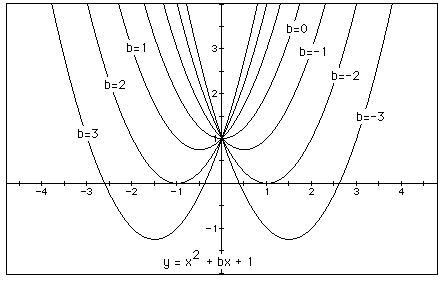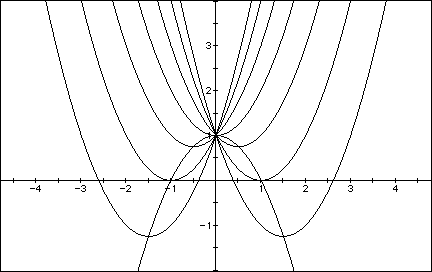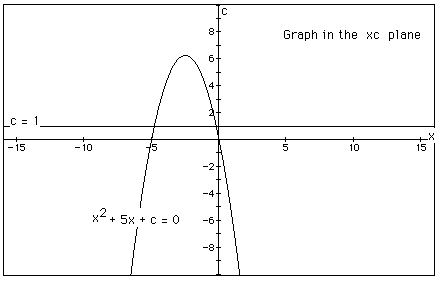

It has now become a rather standard exercise, with availble
technology, to construct graphs to consider the equation
and to overlay several graphs of
for different values of a, b, or c as the other two are held
constant. From these graphs discussion of the patterns for the
roots of
can be followed. For example, if we set
for b = -3, -2, -1, 0, 1, 2, 3, and overlay the graphs, the
following picture is obtained.

We can discuss the "movement" of a parabola as b is changed. The parabola always passes through the same point on the y-axis ( the point (0,1) with this equation). For b < -2 the parabola will intersect the x-axis in two points with positive x values (i.e. the original equation will have two real roots, both positive). For b = -2, the parabola is tangent to the x-axis and so the original equation has one real and positive root at the point of tangency. For -2 < b < 2, the parabola does not intersect the x-axis -- the original equation has no real roots. Similarly for b = 2 the parabola is tangent to the x-axis (one real negative root) and for b > 2, the parabola intersets the x-axis twice to show two negative real roots for each b. This can be confirmed by examining the quadratic formula. The quadratic formula provides the roots of the quadratic equation. The roots are the solution to:


Look at the following part of the quadratic formula, which is called the discriminant:
If the discriminant is less than 0, the equation does not have any real roots. This is because the term under the square root in the quadratic formula would be less than 0. You can not have a real root if the term is less than 0. Since in the previous example I was given that a =1, b=2, and c=1, I know that b =2, will set the discriminant equal to 0, this gives one real root and will be tangent to the x-axis. If b is greater than two I will obtain a positive discriminant. Thus, when I plug a, b, and c into the two parts of the quadratic formual I will obtain two real roots. If b is less than two my discriminant is less than 0 and no real number under a square root is less than 0, so I will not have any real roots.
How would the graph of the locus of these parabolas give the
graph of:
In the graph that follows you can see that the locus of this
graph is indeed this parabola. Where does this relationship come
from?

I know that in order to obtain the parabola:
I must find the set of points that are equidistant from a line, the directrix and a point, the focus. The locus of this forms the parabola. I know that I can use the equation:
to help me determine where this focus and directrix are located. 4p is the distance from the vertex of the parabola to the focus and is equivalent to the number in front of the:
So, in this case 4p = -1. Therefore:
So the focus of this parabola is down one-fourth of a unit from the vertex of the parabola. Since the parabola is the set of points equidistant from the directrix and the focus the directrix of the parabola must contain the point that is one-fourth of a unit up from the vertex.
Before I can make use of this information I must first find the vertex of the parabola. I know that:
is equivalent to the x-coordinate of the vertex of the parabola. So for the parabola:
since b=0, I can determine that the x-coordinate of the vertex is 0. Then, if I plug x=0 into the quadratic equation I then determine that the y-coordinate of the vertex is 1. Therefore the vertex of this parabola is (0, 1).
So I know that the focus of the parabola must be the point (0, 3/4) and the directrix must contain the point (0, 5/4).
The vertices of the parabolas:
![]()
must form a relationship with:
![]()
in order to trace out the parabola
The relationship has to do with :
![]()
as b varies.
Consider again the equation
Now graph this relation in the xb plane. We get the following
graph.

This is not suprising because a parabola is formed by a hyperbola and a straight line. Look at the following two equations:
Then by substitution:
If I multiply by x I obtain:
By subtraction, I then obtain:
which is the equation of a parabola.
If we take any particular value of b, say b = 3, and overlay this equation on the graph we add a line parallel to the x-axis. If it intersects the curve in the xb plane the intersection points correspond to the roots of the original equation for that value of b. We have the following graph.

For each value of b we select, we get a horizontal line. It is clear on a single graph that we get two negative real roots of the original equation when b > 2, one negative real root when b = 2, no real roots for -2 < b < 2, One positive real root when b = -2, and two positive real roots when b < -2. Where the line crosses the hyperbola gives the same real roots for b =3, as where the graph of the parabola:
crosses the x-axis.
Consider the case when c = - 1 rather than + 1.

In this case the number of real roots of the equation is always 2. This is because in examining the discriminant:
I note that the discriminant will always be positive. Since c is fixed at -1 and a is fixed at +1 you will always get:
So every equation of the form:
has two real roots. This can be extended to every equation of the form:
In the following example the equation
is considered. If the equation is graphed in the xc plane, it is easy to see that the curve will be a parabola. You can see that this will be a parabola because:
This also explains why the graph of a parabola in the xc plane
goes down. For each value of c considered, its graph will be
a line crossing the parabola in 0, 1, or 2 points -- the intersections
being at the roots of the orignal equation at that value of c.
In the graph, the graph of c = 1 is shown. The equation
will have two negative roots -- approximately -0.2 and -4.8.

There is one value of c where the equation will have only 1
real root -- at c = 6.25. For c > 6.25 the equation will have
no real roots and for c < 6.25 the equation will have two roots,
both negative for 0 < c < 6.25, one negative and one 0 when
c = 0 and one negative and one positive when c < 0.
Notice that when I graph:
in the xy plane, the xb plane, and the xc plane I always get the same answer for my roots and always have the same number of real roots. Here is what this looks like:

This concludes my investigation of parabolas in the three different planes.
Contact Me:
Jennifer Shea